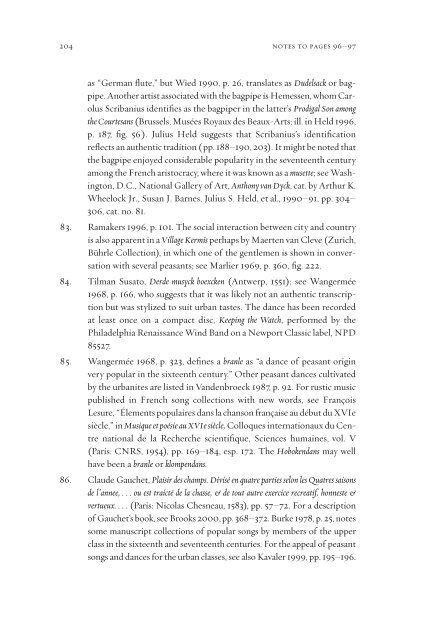Pieter Bruegel and the Art of Laughter - AAAARG.ORG
Pieter Bruegel and the Art of Laughter - AAAARG.ORG
Pieter Bruegel and the Art of Laughter - AAAARG.ORG
Create successful ePaper yourself
Turn your PDF publications into a flip-book with our unique Google optimized e-Paper software.
204 notes to pages 96–97<br />
as “German flute,” but Wied 1990, p. 26, translates as Dudelsack or bagpipe.<br />
Ano<strong>the</strong>r artist associated with <strong>the</strong> bagpipe is Hemessen, whom Carolus<br />
Scribanius identifies as <strong>the</strong> bagpiper in <strong>the</strong> latter’s Prodigal Son among<br />
<strong>the</strong> Courtesans (Brussels, Musées Royaux des Beaux-<strong>Art</strong>s; ill. in Held 1996,<br />
p. 187, fig. 56 ). Julius Held suggests that Scribanius’s identification<br />
reflects an au<strong>the</strong>ntic tradition ( pp. 188–190, 203). It might be noted that<br />
<strong>the</strong> bagpipe enjoyed considerable popularity in <strong>the</strong> seventeenth century<br />
among <strong>the</strong> French aristocracy, where it was known as a musette; see Washington,<br />
D.C., National Gallery <strong>of</strong> <strong>Art</strong>, Anthony van Dyck, cat. by <strong>Art</strong>hur K.<br />
Wheelock Jr., Susan J. Barnes, Julius S. Held, et al., 1990–91, pp. 304–<br />
306, cat. no. 81.<br />
83. Ramakers 1996, p. 101. The social interaction between city <strong>and</strong> country<br />
is also apparent in a Village Kermis perhaps by Maerten van Cleve (Zurich,<br />
Bührle Collection), in which one <strong>of</strong> <strong>the</strong> gentlemen is shown in conversation<br />
with several peasants; see Marlier 1969, p. 360, fig. 222.<br />
84. Tilman Susato, Derde musyck boexcken (Antwerp, 1551); see Wangermée<br />
1968, p. 166, who suggests that it was likely not an au<strong>the</strong>ntic transcription<br />
but was stylized to suit urban tastes. The dance has been recorded<br />
at least once on a compact disc, Keeping <strong>the</strong> Watch, performed by <strong>the</strong><br />
Philadelphia Renaissance Wind B<strong>and</strong> on a Newport Classic label, NPD<br />
85527.<br />
85. Wangermée 1968, p. 323, defines a branle as “a dance <strong>of</strong> peasant origin<br />
very popular in <strong>the</strong> sixteenth century.” O<strong>the</strong>r peasant dances cultivated<br />
by <strong>the</strong> urbanites are listed in V<strong>and</strong>enbroeck 1987, p. 92. For rustic music<br />
published in French song collections with new words, see François<br />
Lesure, “Élements populaires dans la chanson française au début du XVIe<br />
siècle,” in Musique et poésie au XVIe siècle, Colloques internationaux du Centre<br />
national de la Recherche scientifique, Sciences humaines, vol. V<br />
(Paris: CNRS, 1954), pp. 169–184, esp. 172. The Hobokendans may well<br />
have been a branle or klompendans.<br />
86. Claude Gauchet, Plaisir des champs. Divisé en quatre parties selon les Quatres saisons<br />
de l’annee, . . . ou est traicté de la chasse, & de tout autre exercice recreatif, honneste &<br />
vertueux. . . . (Paris: Nicolas Chesneau, 1583), pp. 57–72. For a description<br />
<strong>of</strong> Gauchet’s book, see Brooks 2000, pp. 368–372. Burke 1978, p. 25, notes<br />
some manuscript collections <strong>of</strong> popular songs by members <strong>of</strong> <strong>the</strong> upper<br />
class in <strong>the</strong> sixteenth <strong>and</strong> seventeenth centuries. For <strong>the</strong> appeal <strong>of</strong> peasant<br />
songs <strong>and</strong> dances for <strong>the</strong> urban classes, see also Kavaler 1999, pp. 195–196.












